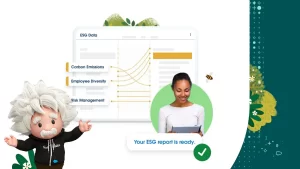Table of Contents
The European Union (EU) is introducing the Corporate Sustainability Reporting Directive to promote greater corporate accountability on environmental and social issues.
In January 2023, the CSRD was implemented, modernizing and strengthening the guidelines regarding the social and environmental information companies must report. A more comprehensive range of large enterprises and listed SMEs will now be required to report on their sustainability. Furthermore, certain non-EU companies will have to report if they generate over EUR 150 million on the EU market.

01
of 05
What is the Corporate Sustainability Reporting Directive?
The Corporate Sustainability Reporting Directive is a European (EU) legislation that requires EU businesses to disclose their environmental and social impacts and how their environmental, social and governance (ESG) actions affect their business.
This new reporting directive, effective January 2023, significantly strengthens existing sustainability reporting requirements. It mandates large companies and listed entities within the EU to disclose their environmental and social impact alongside their financial performance. This increased transparency aims to empower stakeholders – investors, consumers, and regulators – to make informed decisions based on a company’s sustainability practices.
Well, just in time, during Dreamforce 2023, Salesforce announced two new features for Net Zero Cloud – the CSRD Report Builder and Materiality Assessment. The Report Builder automates CSRD report generation, and the Materiality Assessment helps organizations determine what is material – both to their business and broader societal impact, the “double materiality” assessment that is a requirement.
How to Navigate CSRD Reporting?
Salesforce announced new features for Net Zero Cloud, a sustainability management solution. These include capabilities that support companies that need to meet these EU sustainability disclosure requirements with AI features that help ESG reporting, making reporting for the Corporate Sustainability Reporting all much easier.
And let’s talk about timing! With the EU dropping this “bomb”, NZC couldn’t have picked a better moment to beef up its arsenal. The CSRD is basically making everyone sit up and take notice, with more companies than ever before needing to spill the beans on their sustainability efforts.
Net Zero Cloud’s latest features address these challenges head-on. The CSRD Report Builder streamlines report generation according to this law requirements, while the Materiality Assessment tool helps companies identify the most relevant ESG topics for their business.
02
of 05
How AI Improves the ESG Reporting Capabilities of Net Zero Cloud
Salesforce Net Zero Cloud enables your company to easily assess and report on your environmental footprint across scopes 1,2 and 3 as you can deep dive into our Carbon Footprint: Tracking and Measuring Your Impact article. It also manages social and governance metrics and generates ESG reports aligned to SASB, CDP, GRI, and now, the EU’s CSRD standards. The latest innovations include:
Einstein for Net Zero Cloud
With Einstein incorporated into your platform, you will receive suggestions based on prompts aligned with specific reporting.
- Take Salesforce’s example: You can leverage your company’s ESG data from the previous year and upload documents such as impact reports and other data such as company emissions. Then, Net Zero Cloud will use this data to automatically generate responses for each written question in the report.

CSRD Report Builder
Companies can now automate ESG reporting to align with CSRD requirements using the CSRD Report Builder for Net Zero Cloud, as the world shifts from voluntary to mandatory ESG disclosures. This includes double materiality. This new feature expands the collection of existing Net Zero Cloud report builders, including GRI, CDP, and SASB found in Salesforce’s Disclosure and Compliance Hub.
Materiality Assessment
This new feature is designed to assist ESG managers in identifying the most material topics related to their business. It offers a customizable survey that enables them to obtain stakeholder input easily, rank the importance of each topic, calculate scores, and visualize the results in a matrix. The results of this survey can be very helpful for ESG managers in designing their company’s ESG program and reporting strategy more effectively.
03
of 05
Impact on Businesses: Challenges and Opportunities
The CSRD presents both challenges and opportunities for businesses.
- Challenges: Some hurdles companies face include implementing robust reporting systems, gathering and analyzing sustainability data, and potentially incurring additional costs.
- Opportunities: Increased transparency fosters trust with stakeholders, strengthens risk management by identifying sustainability-related vulnerabilities and could open doors to innovation in eco-friendly solutions.
04
of 05
Salesforce’s Net Zero Commitment and CSRD Alignment
Salesforce has pledged to achieve net zero emissions, aligning perfectly with the CSRD’s emphasis on sustainability reporting. Their commitment goes beyond their operations, encompassing their entire value chain. This proactive approach positions Salesforce as a leader in the sustainability space, attracting environmentally conscious customers and investors.
By embracing the CSRD’s requirements, companies like Salesforce can demonstrate their commitment to a sustainable future. The directive fosters a more transparent and responsible business landscape, benefiting both businesses and the environment.
05
of 05
How a Salesforce Partner Can Help
At Stellaxius, a Salesforce implementation boutique, we specialize in helping organizations leverage the power of Salesforce technology to achieve their sustainability goals. As you commit to becoming net zero, you must have the right tools and expertise to navigate this complex journey effectively. Here’s how we can support you in aligning with the Corporate Sustainability Reporting Directive (CSRD) and utilizing Salesforce Net Zero Cloud to transform your business:
1. Comprehensive Sustainability Reporting
The CSRD requires detailed and transparent sustainability reporting. We help you integrate Salesforce Net Zero Cloud with Salesforce to seamlessly capture, track, and report on key sustainability metrics. This ensures compliance with CSRD requirements and provides stakeholders with precise, reliable data on your environmental impact.
2. Custom Implementation and Integration
Every organization’s sustainability journey is unique. Our team of experts will tailor the Salesforce Net Zero Cloud implementation to meet your specific needs. We ensure smooth integration with your current business processes, allowing you to efficiently manage and monitor your carbon footprint, energy usage, and other critical sustainability metrics.
3. Training and Support
Transitioning to a net zero strategy involves significant change management. We offer comprehensive training for your team to ensure they are proficient in using Salesforce Net Zero Cloud. Additionally, our ongoing support services ensure that you can continually optimize your sustainability processes and adapt to new regulations or business needs.
Sustainability is an evolving field, and staying ahead requires continuous improvement. We work with you to regularly review and enhance your sustainability initiatives, incorporating new features and innovations from Salesforce Net Zero Cloud to ensure you are always utilizing the most effective tools and strategies.
At Stellaxius, we are dedicated to helping you transform your business through cutting-edge technology and sustainable practices. Partner with us to navigate the complexities of the CSRD, harness the power of Salesforce Net Zero Cloud, and achieve your net zero ambitions.






